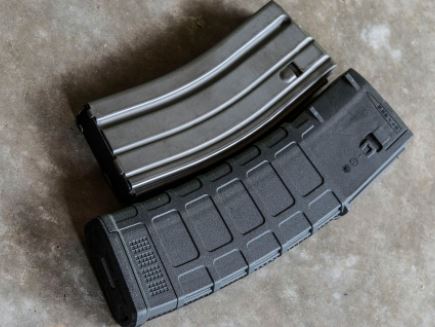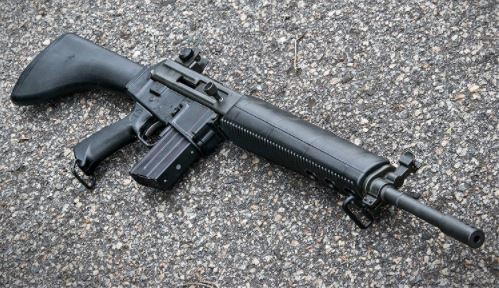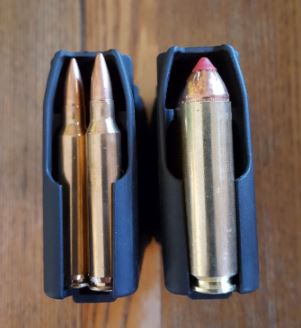STANAG magazine

A STANAG magazine or NATO magazine is a type of detachable firearm magazine proposed by NATO in October of 1980. Not long after NATO's acceptance of the 5.56×45 NATO cartridge, Draft Standardization Agreement (STANAG) 4179 was proposed in order to allow NATO members to easily share rifle ammo and magazines down to individual soldiers. The United States' M16 rifle's magazine proportions were the ones proposed for standardization. Many (but not all) NATO countries subsequently developed or purchased rifles that would accept this type of magazine. The standard was never officially ratified, and remains a "Draft STANAG".
Likewise, another Standardization Agreement (STANAG 4181) was proposed, which would have standardized the stripper clips for loading the aforementioned STANAG 4179 spec magazines, however this agreement also remained a draft and was never officially ratified by NATO.
Contents
Magazine Specs and Scope of STANAG 4179
The STANAG magazine concept is only an interface, dimensional and controls requirement (e.g. magazine latch, bolt stop, and so on). Therefore, it not only allows one type of magazine to interface with various weapon systems, but also allows STANAG magazines to be made in various configurations and capacities, so long as it meets those basic specifications. The standard capacities of STANAG-compatible magazines are 20 or 30 rounds of 5.56×45mm NATO ammunition. There are also 5 round, 10 round, 40 and 50 round box magazines, as well as 60 and 100-round "casket" magazines. There are also 90-round "snail-drum" magazines, and even 100-round drum magazines. There has also been a 150-round drum magazine produced (e.g. Armatac Industries' "SAW-MAG").
Issues and Improvements
The STANAG magazine is fairly compact in comparison to other 5.56 magazines, but this means it has also been criticized for lack of durability, and a need to be treated more carefully than should be required in combat situations. STANAG 4179 is only a dimensional standard, so production quality between various manufacturers is not necessarily. Magazines have been manufactured with lightweight aluminum or plastic bodies and other inexpensive materials in order to keep costs down, or to meet requirements that treat the magazine more as a disposable item, as opposed to one that is meant to stand up to repeated combat use.
This led the U.S. military to begin accepting improved STANAG magazines as of March of 2009. In order to increase reliability, these magazines incorporate heavier, more corrosion resistant springs and new tan-colored anti-tilt followers. As a result, many commercial magazine manufacturers now also offer improved STANAG-compatible magazines. These magazines are made from high-grade stainless steel bodies, rust- and set-resistant chrome-silicon springs, and anti-tilt followers. There are also highly reliable polymer magazines (e.g. Magpul's "PMAG" etc). Some offer features such as view windows, others are translucent, and so on.
ARDEC began development of a new magazine design in July 2013 to address feeding issues of older designs with the new M855A1 Enhanced Performance Round. It was first made public in 2014 and completed development in mid-2016 as the Enhanced Performance Magazine. The magazine uses a blue follower and a tan body which presents the rounds with a better angle to the weapon's feedway, preventing the hardened steel tip of the EPR from contacting the aluminum feed ramp of the M4 carbine, increasing average rounds between stoppage by 300%.
Firearms Compatible With STANAG Magazines
AR-15 / M16 Type Firearms
- ArmaLite AR-15 - And nearly all military and commercial variants, of which many are listed below in this section.
- AAC Honey Badger

- Barrett REC7
- CAR 816
- Colt M16
- Colt M4
- Diemaco C7 and C8
- G5 carbine
- Haenel MK 556
- Heckler & Koch HK416
- LWRC M6
- Marine Scout Sniper Rifle
- Norinco CQ
- PVAR
- R5 RGP
- Remington GPC
- Remington R-15
- Ruger SR-556
- Safir T-15, T-16 and T-17
- SIG MCX
- SIG Sauer SIG516
- Smith & Wesson M&P15
- SOAR
- Type 86
- Type 91
- Unified Weapon Systems, Unified Patrol Rifle
- Windham Weaponry WW-15
- Z-M Weapons LR 300
- Rock River Arms LAR-15
Non-AR-15 / M16 Style Rifles

- Ares SCR
- Armalite AR-180B
- Beretta AR70/90
- Beretta ARX-160
- Beretta Rx4 Storm
- Bernardelli VB-SR
- Benelli MR1
- Bofors Carl Gustaf Ak 5
- Bushmaster ACR
- Bushmaster M17S
- CETME Model L
- CZ BREN 2
- Daewoo K1
- Daewoo K2
- Daewoo K3
- Daewoo K11
- Diseños Casanave SC-2005
- EMERK
- FAD assault rifle
- FAMAS G2
- Fateh assault rifle
- FN F2000
- FN FNC
- FN Minimi/M249 SAW
- FN SCAR-L
- Fort Ellis XR-86
- FaB 556
- Heckler & Koch G41
- Howa Type 89
- IMBEL IA2
- IMBEL MD2
- IMI Negev
- IMI Tavor TAR-21
- IWI Tavor X95
- IWI Galil ACE N
- Kalashnikov SR-1
- Kel-Tec PLR-16
- Kel-Tec RDB
- Kel-Tec SU-16
- KH-2002
- LAPA FA-03
- Magpul PDR
- MKEK MPT
- MSAR STG 556 "E4 Model"
- MSBS Grot
- Nabi assault rifle
- Norinco QBZ-97
- Norinco Type 03 assault rifle (export models)
- Pindad SS1
- Pindad SS2
- Pindad SS3
- Robinson Armaments M-96 "Expeditionary Rifle"
- Robinson Armaments XCR
- Rung Paisarn RPS-001
- SA80
- SAR-21 (export models)
- SAR-80
- SR-88
- SIG 556
- Sterling SAR-87
- Leader T2 MK5 rifle
- Type 65
- VB Berapi LP06
- VHS
Manually-Operated Rifles
- BMS Cam rifle
- Crossfire MKI
- Mossberg MVP
- ISSC Pump Action Rifle (PAR)
- LW-S1
- POF USA ReVolt Light
- Remington Model 7615P
- Ruger American - "Ranch" and "Predator"
- Troy Pump Action Rifle (PAR)
- Voere S16
- Q Mini FIX
- Aftermarket STANAG bottom metals are also available for the Remington Model 700 (modification by gunsmith required).
Rifles Convertible to Accept STANAG Magazines
- CZ-805 BREN (housing conversion).
- Heckler & Koch G36 (modular magazine well).
- IMI Galil (through adaptor).
- SAR 21 (swapping lower receiver with the one from export model..?)
- Steyr AUG (through right hand only STANAG magazine stock assembly).
- CM901 (with 5.56 adapter block).
- Wz. 1996 Beryl (via adaptor).
Loading Tools (STANAG 4181)
Loading a STANAG magazine, especially those of large capacity and high spring pressure pushing the rounds to the top of the device, can be be a difficult task. Many devices have been made available in order to to make this simpler. They are most commonly known as magazine loaders, stripper clips, "spoons", or "stripper clip guides". There are a wide range of commercial and military type loading tools available for STANAG magazines. One such universal tool was proposed in "Draft STANAG 4181" - a type of stripper clip and guide tool for standardization based on the USGI M16 rifle stripper clips and guide tools. However, just as with Draft STANAG 4179, NATO did not ratify this equipment formally, though just as with their corresponding magazines, this type of equipment has been used by many nations more informally, even if not officially on paper.
Other Notes And Information

- The "RAM-LINE 30-round COMBO MAG" is a uniquely notable STANAG magazine. These commercial translucent plastic magazines can be used in both AR-15 type rifles and Ruger Mini-14 type rifles.
- Magnolia States Armory offers an adapter that allows the use of STANAG magazines in 5.56mm Galil rifles as well as one that works in a variety of 5.56mm AK-47 type rifles such as the Saiga, WASR3 and Norinco rifles.
- While STANAG magazines are typically loaded with 5.56 mm NATO ammo, they are also used for other calibers as well, such as .25-45 Sharps, .277 Wolverine, .300 Blackout and others that are directly based on the 5.56 NATO cartridge generally function. Likewise, much larger and heavier-hitting rounds such as the .450 Bushmaster will feed from a typical STANAG magazine but in "single stack", which of course will mean reduced capacity (shown to the right).
- There are also a wide range of dummy STANAG magazines in a variety of sizes, weights and colors for training purposes, as well as for use in various airsoft AR-15 style rifles, and others.
Additional Information
- List of AR platform cartridges
- SR-25 pattern magazine, a scaled up version of the STANAG magazine for .308 based cartridges.
- AICS style magazine, an emerging standard for bolt action rifle magazines.